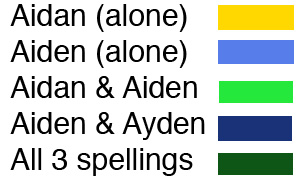
Main Menu - Misc. - Clothing/Textiles - Medieval Wales - Names - Other Medieval - Publications - Harpy Publications
Part II: The diverse roots of the Aidan-Rhyme names
Part III: Near-rhymes and predictions for new candidates for popularity
Note: The map videos are QuickTime files. This is my first project using embedded videos so I'm still working on the best presentation. My apologies to anyone who is not yet able to view them.
Looking at the rise of all these name-groups in parallel, all starting to shoot up at roughly the same time, you'd think that they're all part of some single fashion, ruled by the rhyme. But when you look at how each individual name spreads geographically, something even more curious happens. The geographic data is taken from the Babyname Wizard "name mapper". In this case, it plots the relative popularity of a name in each of the 50 states, but only for names appearing in the 100 most popular for that state. So some of the spelling variants that show up in our top 1000 list for the entire USA never make the cut-off for the map. I'm going to oversimplify a bit by charting a simple "yes/no" for each state and leaving off Alaska and Hawaii (not because they aren't interesting, but because I'm looking at a more big-picture trend).
Even though Aidan isn't the first of the rhyme-group to make the top 1000 lists, and isn't even the most popular of the groups at the beginning of our period of interest (starting in 1990), I'm going to start here when looking at the geographic spread patterns simply because I've always tended to view the rhyme-group phenomenon as centering around this name. Rightly or wrongly.
The "classic" spelling Aidan starts out in New England, takes a few years to establish itself more broadly in that region, then suddenly jumps to the Pacific Northwest (and Alaska). The year after that it's established in a long narrow strip that -- perhaps entirely coincidentally -- corresponds roughly to the old Route 66. In the two following years the strip broadens and then the name is pretty much everywhere for a few years before starting to disappear irregularly, mainly along the Rocky Mountain strip.
Only two other variants of Aidan achieve enough popularity to make the distribution maps. (Unsurprisingly, they're the two that also have the highest overall popularity.) Aiden makes the map in 2001, the year that Aidan establishes itself along Route 66 and initially focuses on the core New England area where Aidan first appeared. But within two years Aiden has swept across the entire US except for the deep south swath from Texas to Georgia, which falls the next year. For the last several years, Aiden has been increasing in popularity fairly uniformly in all states while Aidan has begun to disappear.
Ayden moves in the year after Aiden has completed its sweep of the states (in 2005), jumping to a significant presence in Maine, the Dakotas, and several other scattered states. It spreads out somewhat patchily over the next few years, filling in the eastern half of the country but less popular in the west.
Overall, Aidan seems to have done all the major systematic market penetration, allowing Aiden to sweep the board quickly once it appeared. Ayden behaves very much as a variant specifically of Aiden (and not directly from Aidan) as Ayden never appears on the maps anywhere or any time that Aiden does not also appear.
The following map shows all three spelling variants together, with Aidan in gold, Aiden in medium blue, the overlap between those two in medium green, and with the presence of Ayden darkening whichever base color it occurs with (i.e., either dark blue or dark green, since you never get Aidan and Ayden without also getting Aiden).

Recall that Braydon / Bradon / Braddon / Bradden comes from a collection of (unrelated) surnames and place-names of English origin. Given that it shows up in the U.S. top 1000 names periodically throughout the entire 20th century, we wouldn't necessarily expect its appearance in the top 100 state maps to show an "infection" pattern similar to Aidan. Instead we might expect it to pop up randomly in a variety of places -- perhaps ones where other names with the B-R-(N)-D-(N) pattern are popular (which is another entire discussion). But we'd be wrong.
Instead, the spelling Brayden shows up on the map first in Utah (in 1992) and remains isolated there for about six years, only venturing out occasionally into Idaho. This is a pattern that strongly suggests popularity in Mormon communities. When the name finally breaks out into broader popularity, it's in the central and northern portions of the Rockies/Great Plains states. Only after four years incubating in that region does it spread further into the Midwest and along the Mississippi River basin. By 2005 the holdouts are the Hispanic edge (all the states bordering Mexico, plus Florida) and the cluster of states around New York City. But by 2009 the name appears everywhere except California.
Two other spelling variants in this group make the maps, but we'll discount Braeden, which makes its sole appearance in South Dakota in 2006. Braden, on the other hand, has nearly the same pattern as Brayden at nearly the same time. It shows up one year earlier (1991) again in Utah and rises quite high in the charts there (in the 50s) before it branches out anywhere else. This time the first foray is to Oklahoma, but Idaho is also an early adopter, again suggesting a Mormon connection. Through 2001 this spelling remains confined roughly by Utah/Idaho on the west and by the stack of states from North Dakota down to Oklahoma on the east. Its spread after that is mostly through the Midwest down to the Gulf. With the brief exception of Maine and New Hampshire in mid-decade, it never makes it east of the Appalachians. (There's also a brief appearance in Hawaii at this time.) But after 2005 it falls off in absolute numbers for the entire country and starts losing individual states. By 2009 Braden has dwindled to only Wisconsin.
The map shows "Brayden" in blue, "Braden" in red, and both appearing together in purple.
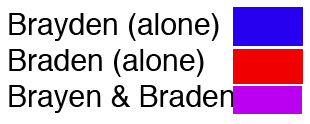
Of the three name-groups that appear in the top 1000 charts before the '90s, Hayden is the one that behaves as if it were a widely distributed name that rises to higher popularity in a diffuse way. It first hits the state top-100 maps in 1991 simultaneously in Utah and Arkansas. Its popularity spreads out from those two centers to their immediately neighboring states for the next seven years. Then starting in 1999 the rest of the country starts filling in almost randomly. Only California, New Mexico, and a cluster including New York, New Jersey, Massachusetts, and Connecticut never show it in the top 100 for boys.
None of the Aidan or Brayden variants show up in the top 1000 names for girls, but Hayden hits the top 1000 names for girls in 1998 (which, you recall, is the year that the male Aidan-rhyme names all start their climb in the charts) and has been increasing steadily since then. And in 2007, the year that boys start losing states on the top-100 maps, girls start showing up there. There's no particular geographic pattern to the states where female Haydens show up, but it's interesting that girls make the top 100 in New Mexico while boys never did (yet).
Since the spelling "Hayden" is the only one that shows up on the top-100 state maps, I've stuck to a single combined male/female presentation.

Caden is the first of the Aidan-rhyme groups that only hits the top 1000 chart starting in the '90s. It shows up in a larger number of spellings than the older names (although fewer than appear for Jayden, even though Caden doubles its options by C/K alternations). The multiplicity of spellings complicates things slightly for showing the geographic spread, but we'll start with just the most popular pair: Caden and Kaden.
As you can see in the overall popularity graph above, Caden and Kaden track almost identically in their rise (and recent fall) of popularity, which might lead us to predict that their geographic spreads will be similar as well.
Like Brayden, the spread of Caden/Kaden suggests a beginning as a Mormon-linked fashion, starting out from the Utah/Idaho nexus. After several years on the state top-100 maps confined to Utah and its immediate neighbors, it spreads east across the Great Plains, then advances into the Midwest and Pacific Northwest, followed by the South and New England, and only briefly brushing into the mid-Atlantic coast briefly before starting to lose ground across the country.
As a general pattern, Kaden tends to move up first in western states while Caden tends to be on the forefront in the eastern half of the country. Caden also starts disappearing earlier in the western states.
None of the spellings of this name-group ever hit the maps in the Southwest corner (California, Arizona, New Mexico) or in the greater New York metro cluster (New York, New Jersey, Massachusetts, Connecticut).
This video shows just the Caden/Kaden spread.
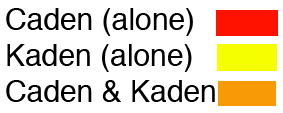
Cayden/Kayden are the next most popular spellings for this name-group and behave roughly similarly to Caden/Kaden, understanding that they start later and spread less extensively. In particular, the geographic preference is somewhat more pronounced with Kayden more likely to appear in western states and Cayden more likely in eastern states.
An exception to the geographic preference occurs in New England where both spellings are popular, as well as being the location for the only appearances of Kaiden on the state maps. None of the other spelling variants make the maps.
This video adds Cayden, Kayden, and Kaiden as paler dots on top of the Caden/Kaden graphics.
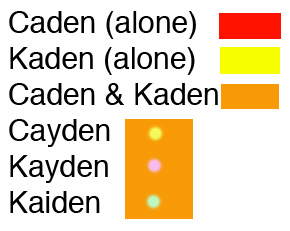
Although Kayden shows up in the girls' top 1000 from 2003 onward, it never makes the cut for the top-100 maps.
Like Hayden, the Jayden group of names behaves geographically like a name that has been mildly popular across a wide region and that tips over into high popularity in a short period of time in many places, rather than showing a distinct spread.
Despite the multiplicity of spellings that show up in the top 1000 names for the nation, only three make it into the state top-100 lists, and only two of those are reasonably widespread. As Jaden, the name first hits the map in Utah (sound familiar?) in 1994 with Jayden following closely behind. But then we quickly see a second nexus in the northern Plains states and in 2001 the name explodes randomly across the country reaching more or less complete coverage around 2004. During the expansion phase, Jaden tends to be at the forefront of the spread but even as the name-group as a whole covers the country, Jaden is losing territory and retreating to a stronghold in the South and Mid-Atlantic regions. Jaiden appears rarely and only in states where both other spellings are also in the top 100.
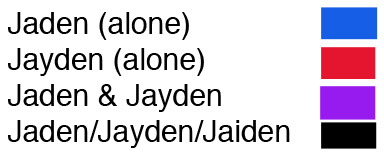
Another similarity between the Jayden group and the Hayden group is that girls' as well as boys' use shows up in the state top-100 maps, although the appearance of girls' usage is fairly spotty and random. There's only one point where girls make the charts when the boys don't: Maine in 2004 (sandwiched between two years when the boys are also popular there). Here's the spread of the Jayden group again with the girls' names added in as pale dots on top of the boys' video. Again, three spellings show up, but in this case Jadyn is substituted for Jaiden. The top popularity for girls is located very generally through the Great Plains and in a strip running up from Mississippi to West Virginia, with a brief appearance in New England.
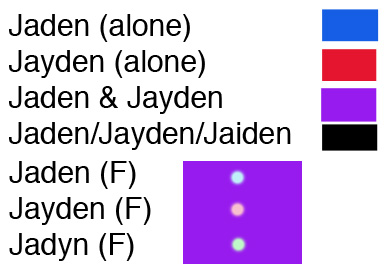
Continue to In Aid of Aidan: Part V - Spelling Fashions
Return to Index of Name Essays
This site belongs to Heather Rose Jones. Contact me regarding anything beyond personal, individual use of this material.
Unless otherwise noted, all contents are copyright by Heather Rose Jones, all rights reserved.